
using World Bank Survey Solutions
Photo credit: Heather Moylan, World Bank
The Malawi National Statistical Office (NSO), in collaboration with the World Bank’s Living Standards Measurement Study (LSMS), disseminated the findings from the Fourth Integrated Household Survey 2016/17 (IHS4), and the Integrated Household Panel Survey 2016 (IHPS), on November 22, 2017 in Lilongwe, Malawi. Both surveys were implemented under the World Bank Living Standards Measurement Study-Integrated Surveys on Agriculture (LSMS-ISA) initiative, with funding from the United States Agency for International Development (USAID).
The IHS4 is the fourth cross-sectional survey in the IHS series, and was fielded from April 2016 to April 2017. The IHS4 2016/17 collected information from a sample of 12,447 households, representative at the national-, urban/rural-, regional- and district-levels.
In parallel, the third (2016) round of the Integrated Household Panel Survey (IHPS) ran concurrently with the IHS4 fieldwork. The IHPS 2016 targeted a national sample of 1,989 households that were interviewed as part of the IHPS 2013, and that could be traced back to half of the 204 panel enumeration areas that were originally sampled as part of the Third Integrated Household Survey (IHS3) 2010/11.
The panel sample expanded each wave through the tracking of split-off individuals and the new households that they formed. The IHPS 2016 maintained a 4 percent household-level attrition rate (the same as 2013), while the sample expanded to 2,508 households. The low attrition rate was not a trivial accomplishment given only 54 percent of the IHPS 2016 households were within one kilometer of their 2010 location.
The IHS4 2016/17 and the IHPS 2016 were the first full-fledged LSMS surveys implemented using the World Bank Survey Solutions CAPI platform. This design feature was crucial for allowing these two rich datasets, composed of household, agriculture, fisheries, community, and individual-level modules, to be made publicly available within six months of the conclusion of fieldwork.
With hopes of spurring government officials, independent researchers and donors to monitor living standards and formulate policies aimed at improving the lives of ordinary Malawians, we are excited to share the links for the data and documentation for the IHS4 2016/17, and the link for the IHPS 2016 (inclusive of the re-released portions of the 2010 and 2013 waves of the IHPS that form a panel with the IHPS 2016 and that have updated sampling weights).

Photo Credit: Emmanual Tsoka, Malawi National Statistical Office
Interesting findings from the IHS4 2016/17:
Education:
- Self-reported literacy (for reading and writing in any language) is 81% percent for males and 66% for females (15 years of age and above)
Non-farm Enterprises (NFEs):
- 45% of urban households & 23% of rural households own or operate at least one NFE
- 73% of NFEs reported are in the wholesale and retail trade industry, 16% in manufacturing, and 5% other services
Shocks:
- In the 12 months preceding the survey 99% of households experienced at least one shock. Shocks most frequently reported:
- 68% of households experienced high prices for food,
- 58% of households experienced irregular rains,
- 46% of households experienced high costs of agricultural inputs
- 36% of households experienced drought
- 13% of households experience low prices for agricultural outputs
Food Security:
- 73% of households felt they did not have enough food over the last 12 months
Agriculture:
- 78% of households were involved in rainy season cultivation,
- 76% of rainy season plots were cultivated with maize, Malawi’s staple crop
- 53% of rainy season plots intercropped,
- 37% of households owned livestock in the 12 months preceding the survey.
Interesting findings from the IHPS 2016:
Demographics:
- The dependency ratio shows a decreasing trend from 1.32 to 1.22 to 1.14 in 2010, 2013, and 2016, respectively.
Education:
- The proportion of household members that never attended school decreased from 20% in 2010 to 11% in 2016.
- There is a shift in type of secondary school household members are currently attending from 7% private in 2010 to 20% in 2016.
Health:
- Among the population of individuals facing an illness in the two weeks prior to their interview, the number seeking treatment at government health facilities fell from 55% in 2010 to 40% in 2016.
Credit:
- In 2010 8% of households had obtained a loan and this increased to 15% by 2013, but fell to 13% in 2016.
Food Security:
- In 2010, 31% of households felt they had very low food security in the week leading up to the interview and this increased to 40% of households in 2013 and up to 56% of households in 2016.
Agriculture:
- The percentage of households involved in rainy season cultivation in rural areas dropped from 95% in 2010 to 90% in 2016,
- More households own livestock up from 44% in 2010 to 48% in 2016.
- The percentage share of rural households receiving any Farm Input Subsidy Programme Voucher dropped from 60% in 2010, to 44% in 2013, and now 36% in 2016.



Join the Conversation